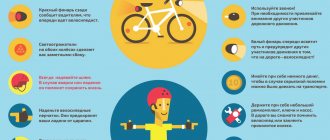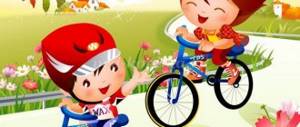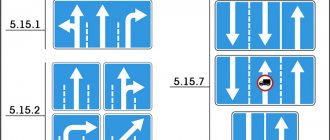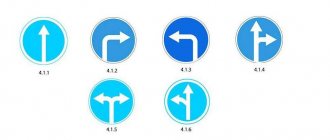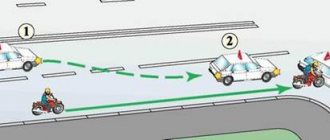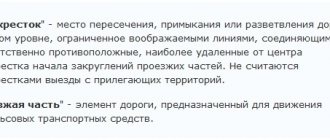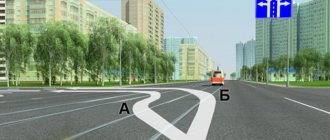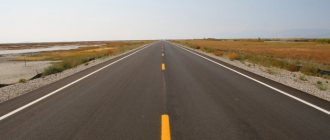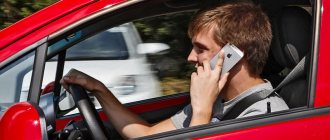Road signs and markings
There are several road signs in the current Regulations that relate to the regulation of cyclists.
Bike path / End of bike path
A "Bike Path" sign means you can only ride a bicycle
3. Sometimes you can walk along a bike path, but only if there is no sidewalk or pedestrian path nearby. At the same time, the pedestrian should not interfere with cyclists.
Footpath / End of footpath
“Pedestrian path” - only pedestrians
4, but if there is no bicycle path nearby, you can ride a bicycle, but without interfering with pedestrians.
Intersection with a bicycle path
The “Intersection with a bicycle path” sign warns drivers or pedestrians that there is a bicycle path ahead and they need to be extremely careful.
Bicycles are prohibited
If there is a “No Bicycles” sign along the roadway, then you are not allowed to ride there, regardless of whether there are obstacles on the sidewalk or bike path or not.
Road markings
“Bike path” markings are applied directly to the asphalt and show where to ride a bicycle:
Bike Lane
A “pedestrian path” is also drawn on the asphalt and shows where to walk:
Footpath
There are places in the city where you can walk and bike. It is designated as follows:
Path for joint movement of pedestrians and cyclists
The place where the bike path crosses the road looks like this:
The place where the bike path crosses the roadway
Where the bike path intersects with pedestrian paths or sidewalks:
Where it is advisable to travel, not worth it, prohibited
When choosing a route, it is recommended to choose roads with low traffic: this way the ride will be more comfortable, faster, and there will be less risk of getting into an accident or being poisoned by exhaust fumes.
You can, but you should not drive on streets that are too wide and have heavy traffic. Of course, an experienced road cyclist will ride everywhere, but if there are more reasonable options, it is better to choose them. Also, do not overuse driving on highways and roads with a large number of heavy vehicles. We must remember that a truck and a bicycle are incomparable things.
It is prohibited to ride a bicycle on highways without traffic lights. The speed of cars on such roads is usually close to 90 km/h even in the right lane, and a modest 25-30 km/h is completely out of place here. It is also prohibited to ride on two wheels in tunnels.
What is prohibited for a bicycle driver?
Cyclists are prohibited from:
Move without holding the steering wheel with at least one hand. Adults, as a rule, use a bicycle for transport, while children ride it for pleasure. Especially stupid adults, when driving on the road, let go of the steering wheel and drive on with their arms crossed. If a cyclist falls, he will stretch out on the road surface along with the bicycle, which is why he may be hit by a nearby vehicle. Ride on sidewalks, pedestrian paths and pavements. Cyclists are still allowed to ride on the side of the road without interfering with passersby moving around or boarding public transport. Paths for pedestrians or sidewalks are intended only for passers-by, since when walking there, any individual must feel protected. Ride on the road
In this taboo lies attention to the safety and security of the cycling enthusiast. Turn left, turn along a highway with tram tracks or with multi-lane traffic in the indicated direction. If you need to turn or turn around, you must go to the pedestrian crossing, get off the bike and move to the other side of the passage. For other transport, take a bicycle in tow
A bicycle trailer with a rigid clutch is allowed to be transported by bicycle. Trying to ride while grabbing the edge of a truck often results in dramatic results. In this situation, the driver of the car does not see the hitched cyclist and does not worry about his safety. All cars drive at an approximate speed of more than sixty kilometers per hour. When avoiding potholes on the highway or hastily braking, an irresponsible cyclist ends up under the wheels of a car. Transport luggage that protrudes beyond the permissible parameters by more than half a meter and impedes coordination. Fishing gear, receivers, and any rods on bicycles interfere with a stable position, mainly when making turns. If a vehicle gets caught on protruding luggage, it can overturn a cyclist. Carry adults. Children aged 2 - 7 years old can only be ridden on an additionally attached seat with footrests. Transporting a person with a large body weight seriously violates the previously mentioned stable position.
Clothing is especially important for safe riding. It's not just about the bike helmet; however, ignoring it results in serious damage even in small falls.
Due to its small dimensions compared to a car and the complete silent ride, the amateur cyclist remains invisible on the road. And the lack of marker signals, reflectors, and bright clothing makes him invisible.
Cyclist on the road
The traffic rules for a cyclist on the road consist largely of simple rules of survival. Traffic violations by cyclists are often fatal. In addition to the mandatory knowledge of the current traffic rules, it is also important to learn and adapt this knowledge for a bicycle. We will not focus on standard knowledge, but rather talk about special cases for a bicycle.
So, let's start with a simple thing - the movement of a cyclist on the roadway is not prohibited by traffic regulations. This means that where there are no additional restrictions imposed by signs and conditions such as "motorway" or "road for motor vehicles", the cyclist has every right to travel. But the bike has a major drawback. Poor security and low visibility. Even heavy rain that catches you on the highway or a dog that chases your bicycle through the entire village can lead to an accident. Accordingly, absolute care must always be taken to avoid errors.
Basic rules to remember
- The cyclist must move along the roadway as close to the right side as possible , preferably no further than 1 m from its edge.
- A cyclist at a pedestrian crossing must dismount and cross the zebra crossing as a pedestrian. Particular attention should be paid here to the case when the crossing is poorly visible (a turn or a parked truck), and the cyclist flies into it without braking. In this case, the rule is completely adequate.
- Need to remember the signs main road and secondary road. In addition, you need to remember the signs indicating the direction of the main/secondary road. Main road - you drive without stopping when crossing an intersection. When turning left from the main road at an intersection, you first let oncoming traffic pass. Then you drive by yourself. If you need to make a right turn, then turn strictly into the far right lane. When driving on a secondary road, you let everyone pass, and when turning, you behave in the same way as on the main road. You also need to know that there is a circular motion. It is indicated by a special sign. The circle is always the main one. There is still a sign One Way. It is no less important.
- You need to remember the rules for exiting (and entering) the roadway from the adjacent territory and the rules for passing equivalent intersections. The right hand rule is generally sacred.
Cyclist safety
Not everyone understands that a bicycle is equal to a car, so on the road a cyclist will need to follow the general rules of movement on the roadway (regarding non-motorized vehicles).
Let's look at what important factors need to be taken into account for the safe movement of cyclists.
Serviceability
Namely, check all the most important parts of the bicycle (handlebars, working brakes), check whether it is equipped with other important parts for driving on the highway:
- reflectors (back, front, and sides);
- flashlights that work at night;
- a working bell to sound a signal.
A cyclist must highlight his bicycle on the roadway so that both the vehicle and the driver himself are clearly visible to all other road users.
Road signs
- priority signs;
- signs of special instructions (informing about the movement of route vehicles, one-way traffic);
- signs that indicate the direction of movement;
- signs prohibiting turns and entry.
However, the cyclist must also know all other signs and strictly observe them. While driving, the bicycle driver should also take into account road markings:
- It is forbidden to cross a solid line;
- do not stand in places that are marked in yellow;
- allow pedestrians to cross the zebra crossing.
Also, the cyclist must move correctly in a group, be extremely attentive and have good reactions.
Speed
But on the road you should develop and maintain a fairly high speed, at least 20 km/h.
Sticking to this speed limit is necessary because driving too slowly can interfere with cars, as they will have to maneuver around the cyclist.
This is especially true on narrower roads, where passing oncoming and passing traffic is difficult.
It is worth noting that high speed is only justified if all other vehicles are moving quickly.
Distance
Side spacing is the distance across the width. Safe and comfortable riding on the road requires maintaining a distance and interval so that if a dangerous situation develops, the cyclist can turn to the side.
If the distance with the car in front decreases, you will need to slow down, or vice versa - speed up if the distance decreases with the vehicle behind.
In case of parallel movement, you should not press too close to parked or passing cars, and there are good reasons for this:
- There is a chance of falling on the car as a result of an uneven road.
- The car may hit the cyclist in some way.
- The door of a stationary car may suddenly open.
So, attentiveness is the key to safe cycling. In this case, you should carefully monitor what is happening on the sides and in front.
The road is movement, so the situation can change every second. It is useful to purchase a special rear-view mirror and attach it to the steering wheel, thanks to which you can also monitor the road from behind.
“Laws of life” for a cyclist on the road
We quickly studied the basic rules that a cyclist will need. The traffic rules requirements for the movement of cyclists are not so strict, but further we will look at even more important concepts that have never been written about anywhere. Let me say briefly that just following the rules will not help a cyclist without additional knowledge.
- A cyclist on the road is like a vampire in the mirror. He's gone. It is not reflected in the mirrors, it gets a little dark and disappears. And everything would be great, but drivers often don’t notice the bike on the road and hit it. This is done unintentionally, but it does not cancel the consequences of the accident. And all this just because a cyclist on the road (especially at dusk, not even to mention at night) is not visible to a motorist. Therefore, when driving on the roadway choose the brightest clothes, install lights and parking signals on your bike. A vest helps a lot. If there is no lighting or lights for your bike, avoid riding at night on public roads. This also applies to other situations with poor visibility (fog, snow, rain).
- Even if the cyclist is right, he is wrong. What does it mean? And the fact that whoever is stronger is right. He is big and iron, and you are meaty and small. It’s a piece of cake for a car to give in to a cyclist. With the guard installed, there won’t even be a dent on the body. A cyclist does not have to prove he is right at the cost of his health ! If you see an idiot who won’t let you through on the main road, let him leave. And so about all situations. There's a huge price at stake.
- Attention for a cyclist is the key to survival . You need to remain extremely vigilant. Although there are rules, they do not protect you. Often unpleasant situations happen just because, for example, you were not noticed at an intersection. And you need to be one step ahead of every motorist.
- Cyclists on the road are not respected or liked . Humble yourself. And do not violate point 2, described just above. It is a rare motorist, to whom praise and honor will be given, who will show a turn signal in front of a cyclist or let him pass. A situation that often occurs is that you are driving on the main road, and a motorist drives out of the adjacent area and does not give you the right of way. Well, they don’t like cyclists because they always swing their license and are hardly noticeable to drivers.
- The doors open abruptly. Often, car enthusiasts open the door of their car without looking in the mirrors. And for a bicycle it’s a wall that grows out of the ground.
- Avoid complex junctions, left turns, overpasses, expressways, etc. Even if traffic is allowed there, there is no need to tempt fate .
- If the car in front of you makes a right turn, then it can push you to the side of the road . Motorists do not always understand that someone may be driving between them and the side of the road. Be careful.
- Think with your head. It's not as scary to violate traffic rules as it is to violate common sense. For example, on an empty road you can turn around or move to the other side. But doing this during rush hour is absurd. You can cross a zebra crossing to speed up the process if you see that the driver has noticed you and is letting you pass. This is good for both you and him. But jumping out from behind a parked truck at a zebra crossing straight in front of oncoming traffic is the height of cretinism.
- Your problems are your problems . Even if you were driving along the road on the right side of the roadway, and suddenly a hatch appeared on the road or an angry dog was chasing you, you can’t just suddenly go a little to the left. You are a participant in traffic, which means you cannot change lanes without a clear understanding that you will not become an obstacle to other vehicles. If you are flooded from a puddle or washed away by rain, this does not mean that you can interfere with motorists.
- Try to avoid falls. Any fall can lead to an even more dangerous injury due to a collision with a car and a difficult situation.
Safe distance and interval: what do these indicators depend on?
Let's start by explaining what the terms “distance” and “interval” actually mean and how they differ. The distance should be understood as the distance maintained between two vehicles (the one in front/behind and the one moving behind/in front of it) while driving or when stopping (parking). The interval similarly implies a distance, only laterally from one vehicle to another vehicle.
A safe distance means maintaining a distance sufficient to completely stop the car in case of emergency braking (without colliding with another vehicle)
Here it is also important to pay attention to the car moving behind you and take this into account when braking.
Where can you ride?
This is a rather complex and conditional subtlety. The fact is that according to the Rules, as many as 7 different formal traffic zones are allowed for cyclists, depending on age and the organization of traffic in a given area.
Best articles: Fixed bike: speed and simplicity
Therefore, first we suggest that you find out where you can travel specifically in your case by interactively answering a few simple questions.
Over 14 years old
On bicycle paths and bicycle pedestrian paths or a lane for cyclists of your choice in any cases, if any, on the right side of the roadway: if there are no above zones or for one or another (objective) reasons it is impossible to ride on them if the width of your bicycle is more than 1 m (including
with cargo), if you are riding in a bicycle convoy,
on the side of the road, if there are no special paths or lanes for cyclists, and it is impossible or impossible to drive along the right edge of the roadway (note that the side of the road is not a roadway); at the same time, you must not interfere with pedestrians (they have priority on the side of the road), on the sidewalk or pedestrian zone, if all of the above is absent or there is no opportunity to drive along them - that is, in fact, this paragraph allows you to drive along pedestrian parks, alleys, etc. .P.; or if you are transporting a child under 7 years old or riding with a cyclist under 14 years old (clause 24.2 of the Rules)
The lane for cyclists is separated from the rest of the road by a solid line and is marked as follows:
And/or with a sign like this:
From 7 to 14 years
- Along the bike paths
- along bicycle and pedestrian paths,
- on the sidewalk,
- along the pedestrian path,
- along the pedestrian zone.
Any of the above is your choice.
Basics of traffic rules for cyclists
Material prepared by: Sherbul Irina Lipovskaya Yulia
The bicycle as a form of transport is gaining popularity in our country every year, and, accordingly, the scale of interactions with other road users is growing.
Unfortunately, accidents involving cyclists in 70% of cases result in severe injuries or death of the rider, so the ability to anticipate the situation on the road and knowledge of traffic rules for a cyclist in the most serious cases can save lives.
In general, most beginners make two main mistakes after buying a bike.
The first is a fear of cars and driving exclusively on sidewalks. In general, this is a common occurrence and this problem goes away with experience.
The second is that some people do not perceive a bicycle as a full-fledged vehicle. However, according to paragraph 1.2 of the traffic rules, it is such and, accordingly, all the rules that are specified for vehicles also apply to cyclists.
Driving along the roadway, bike path and sidewalk, passing through intersections
All cyclists over fourteen years of age are permitted to ride:
- along a special bike path
- on the right edge of the roadway
- on the side of the road
- on the sidewalk
At the same time, each subsequent item on the list implies the inability to move on the previous one. Simply put, this means that riding on the sidewalk is the most extreme option and is only allowed if there is no bike path, no shoulder, or no way to ride on them.
Hand gestures
In addition to light and sound signals, a system of hand gestures is also actively used on the roads for communication.
As a rule, first attracting attention with a short beep. Among such gestures there are symbols whose meaning is not always clear
Circle
When the driver draws a circle in the air with his index finger, he indicates that one of your tires is flat. Sometimes they use the "minor" gesture instead and point to a specific wheel.
Raised hand
Symbol of greeting or gratitude. This gesture is often responded to warnings or other signals from neighbors downstream, using it instead of flashing emergency lights.
Strike the air
When a passing driver mimes a punch in the air with the palm of his hand pointing down, he is telling you that the trunk or hood is open.
Hand placed on chest
A gesture of apology that is used when a person has done something wrong or behaved incorrectly on the road towards others.
Fig
A fig made from fingers is usually used to warn drivers of trucks or large buses that a stone is stuck between the paired wheels of one of the axles. This is a potential hazard for cars behind.
Don't forget that these are all unspoken signs that are not in the rules. They do not oblige you to anything and only express wishes. They do not have to be used, and in case of unpleasant situations, informal gestures cannot serve as an excuse. Only you are responsible for your actions!
Traffic controller signals for pedestrians
There are only 3 traffic controller signals in the traffic rules, but they have different meanings for different road users:
- pedestrians;
- Vehicle;
- trams
We will not consider traffic controller signals for trams in this article, but we will talk in more detail about pedestrians and vehicles.
So, if you see a traffic controller at an intersection, then the first thing you need to determine is who you are: a pedestrian or the driver of a vehicle (for example, a car or). After this, you need to determine by the traffic controller’s gestures whether you can move.
In paragraph 6.10 of the traffic rules, all traffic controller signals are described in the order they appear, however, in practice, a different approach is more convenient. After you have seen the traffic controller, you first need to understand what gestures he makes that allow you to move, without focusing on other road users. With the appropriate gesture, you will be able to continue moving.
Let's consider the traffic controller's gestures for pedestrians. Let me note that at an intersection a pedestrian can find himself in only two possible situations:
- you need to cross the road that goes to the right (red arrow);
- you need to cross the road that goes to the left (blue arrow).
Let the example pedestrian need to cross the roadway following the red arrow. A pedestrian can cross the road in the following situations:
- the traffic controller’s arms are extended to the sides (one to the left, the other to the right);
- The traffic controller's right arm is extended forward and he stands with his back to the side of the road that the pedestrian is about to cross.
In the left picture, the traffic controller’s arms are extended to the sides and the pedestrian can move along the red arrow
Please note that in this case the pedestrian's path intersects with the paths of cars turning right, but cars must give way to the pedestrian. In addition, the traffic controller with his arms extended to the sides can stand not only facing us, but also with his back. Traffic in this case will also be allowed
Movement in this case will also be allowed.
Movement along the blue arrow in the first picture is prohibited.
Let's look at the picture on the right. In it, the traffic controller has his back to us and his right arm is extended forward. In this case, you can also cross the road using the red arrow, but not the blue one.
Please note that if the traffic controller is facing us and his arm is extended forward, then the pedestrian’s movement along the red arrow is prohibited. So, approaching an intersection, a pedestrian should expect the following signals from the traffic controller: So, approaching an intersection, a pedestrian should expect the following signals from a traffic controller:
So, approaching an intersection, a pedestrian should expect the following signals from a traffic controller:
1. Arms extended to the sides. One hand shows the direction from which the pedestrian came, and the other hand shows the direction in which the pedestrian is going to continue his journey.
2. The traffic controller’s hand is extended forward. He stands with his back to the road that the pedestrian is about to cross.
Please note that if the traffic controller's arm is extended upward, pedestrian traffic is prohibited. However, since in practice the majority of pedestrians do not know the traffic controller’s signals, traffic police officers prefer to first stop the traffic flow by raising their right hand, and then show pedestrians with gestures that they can walk. This is not prohibited by the rules
This is not prohibited by the rules.
I note that for crossing the roadway at the wrong traffic signal, a pedestrian may be subject to an administrative fine, which will be considered later.
Driving through intersections and crossing roads
In general, there are four ways to drive through a road intersection: continue straight, turn right or left, or turn around. A right turn for a cyclist is allowed at all regular intersections, as it is made from the extreme right position - the legal place of the cyclist.
A cyclist can also freely ride straight from his lane, and he will have an advantage over those turning right. If the right lane is only for a turn, then to drive straight you need to change lanes into the adjacent lane, having first given way to everyone who does not intend to change lanes.
A bicycle driver is only allowed to turn left and change direction from roads where there is one lane in each direction and there are no tram tracks. By the way, about trams: at intersections they have an advantage over a bicycle; if the red light is not on for it, it does not leave the secondary road or the depot.
The tram is always the main one
Warning instructions for turning: “right” - an outstretched arm to the right, “left” and “turn” - an outstretched arm to the left. The direction of turn must be shown in advance, before the maneuver.
Giving signals when turning - good manners, serious approach
Crossroads are divided into several types:
- Unregulated, equivalent roads.
- Without traffic lights, with a certain priority.
- Adjustable.
The first type of intersections is passed according to the “interference on the right” rule. We look to the right and miss everything that moves from there. When turning left at such intersections, you must give way to the entire oncoming traffic unless it has its own obstacle on the right (to the left of the bicycle).
Driving directions “obstruction on the right”
Intersections with priority are intersections of roads where, according to the rules, some pass “without looking”, others give way. The former move along the main road, the latter are on the secondary road. On the main road, a bicycle has the right of way, just like a car.
However, you need to be careful, slow down a little and pass only if they really allow you to do so.
The most unpleasant maneuver on the main road is turning left. Here you will need to first let through all the passing people, and then the oncoming ones. Sometimes the main road may change direction: there is an information board under the sign. If such a road turns left, then there is no need to let anyone through. On a secondary road, a bicycle is inferior to everyone driving on the main road if they intend to drive straight or to the left, and only to future passing vehicles when turning right.
Intersection with priority passage
Signalized intersections are usually intersections of major streets where left turns will not be permitted. There are two ways to rotate:
- Get off your bike and cross the zebra crossings.
- Drive "at the corner": straight on the green, turn 90 degrees and drive straight on the green again. This can be done where there are no pedestrian crossings, and if there are no cars parked at the edge of the road. In general, the first option is safer.
Turn left from a multi-lane road at the corner (green lines)
You are allowed to drive straight and to the right when the signal is green, including a flashing one. You can complete the intersection on yellow or even red. If the traffic light is flashing yellow or turned off, then we look at the priority signs or get off and cross the road on foot.
There are also T-shaped signalized intersections. They are interesting because you can turn left from a road without a direct passage, even if there are more than one lane. To do this, you need to move to the left lane in advance and calmly turn on green: the bicycle will be to the right of everyone and will not create interference. Don't forget to give turn signals when changing lanes and before turning.
You need to cross the road with a bicycle with your own feet, using a pedestrian crossing. Unfortunately, many people neglect this and ride directly on the saddle. This cannot be done for the following reasons:
- You can hit a pedestrian at a zebra crossing.
- There is a danger of crashing into a curb and falling off your bike.
- A car driver turning a corner may not notice a cyclist and hit him.
The same applies to controlled crossings (without an intersection): the rules clearly state that a cyclist is required to cross the roadway as a pedestrian. A self-respecting bicycle driver always remembers where he can and cannot ride.
This is the wrong cyclist
Cyclist behavior model
The cyclist is obliged to know and follow the requirements of the traffic rules (traffic rules), traffic lights, signs, markings and follow the commands of traffic controllers.
This means that drinking alcohol while driving and talking on the phone while driving is prohibited. It is not allowed for a cyclist to turn on solid lanes or ride oncoming on a highway with traffic in one direction.
Technical requirements
- It is the responsibility of cyclists to maintain their personal bicycle transport in a defect-free technical condition. A bicycle with a functioning brake and a working horn. There is no need to explain why reliable brakes are needed. A bell is especially needed when warning passers-by about the proximity of bicycles. When driving among cars, it is unlikely that the driver will hear the bell.
- Driving in the dark on the highway or in rainy, foggy, snowy weather, in other words, in conditions of incomplete visibility, is allowed only with a light. In front of a bicycle, a flashlight or a light reflector is required, behind - a flashlight and certainly a red reflector, but on the sides (closer to the front and rear dimensions) - amber-colored lights or reflectors, in addition, red rear side lights are allowed. It is absurd and risky to have a red reflector ahead; car drivers rarely notice cyclists, and here, in addition, a kind of confusion is created.
Rules for safe behavior on the roads
- The bicycle driver moves as close as possible to the right side of the track, exclusively in one row with other cyclists.
- When overtaking another cyclist or horse-drawn vehicle, and avoiding stopped traffic, you still need to move away from the right edge of the highway. It is more correct to drive as far as possible around an obstacle, for example, a stopped car, since the driver will immediately begin to get out of it, swinging the door open, or an unseemly person will throw the half-smoked cigarette out of the window.
- Remember that you can only overtake on the left if you don’t want to be pressed against the curb.
Best articles: Brake adjustment (v-brake)
It is also the responsibility of the bicycle driver to give a warning notice before performing any maneuver if there is no vehicle nearby.
Before each turn or lane change and before braking, the cyclist must be warned with a gesture, and immediately when turning the steering wheel or pressing the brakes.
You need to warn the rear rider in time, otherwise your late reaction will become dramatic.
Cyclist signals
Traffic regulations allow the following hand signals:
- The signal for a right turn or change of formation is the left arm extended in the direction of the turn, or the right arm directed away from the body and bent at the elbow at an angle of ninety degrees.
- The signal for a left turn or change of formation is the right arm extended in the direction of the turn, or the left arm directed away from the body and bent at the elbow at an angle of ninety degrees.
- The gesture of braking is raised upward and the right or left arm is straight at the elbow.
Gesturing with your palm does not acquire a privilege in movement, therefore, you always need to be sure that the rear moving driver of the vehicle understands the plans of the cyclist and will not overtake.
If there is a bike path near the route, cyclists are required to move exclusively there. This is indicated by a spherical indicator symbol with a white bicycle on a blue tone.
If the bicycle path is partially destroyed, covered with construction materials, or there are cars parked on it, then the bicycle driver can go around these obstacles along the road, he is not prohibited from doing so.
When traveling abreast, cyclists must ride in only one column along the route, in groups of 10 people. The distance between groups is from eighty to one hundred meters to simplify driving around.
When driving in a group, they use coordinated signals that are sent not to car drivers, but to other cyclists riding behind.
A bump or obstacle on the right side - the right hand points downwards.
A bump or obstacle on the left side - the left hand points downwards.
Initially, these signs are introduced by the head of the cycling group, and other riders are required to immediately reproduce them. You should not wait until you reach a bump or rock on the highway. It is necessary to immediately signal the threat to cyclists moving behind.
Prohibitions
The main prohibitions are:
- drive “hands-free”, especially when driving among pedestrians;
- do not carry volumes that lengthen or expand the dimensions of the vehicle by more than 0.5 meters;
- carry passengers if the design feature of the bike does not allow this;
- transport preschoolers in places that are not equipped for them with child seats or in the absence of them;
- transport the bicycle in tow.
When traveling on a bicycle of any design, you should strive not so much to blindly follow the rules of the road, but to be attentive to other road users. Sometimes, it is better to show restraint and let a road bully pass than to prove your priority to him at the cost of your own health.
General provisions[edit]
A bicycle is defined as “a vehicle, other than a wheelchair, having two or more wheels and generally propelled by the muscular power of its occupants, which may have an electric motor of up to 0.25 kW (rated), switching off when exceeding 25 km/h" (traffic rules 1.2). A cyclist, according to the Rules, qualifies as a bicycle driver. After the introduction of a clarifying amendment, “Pedestrians are considered persons ... who use roller skates, scooters and other similar means for transportation.” (Clause 1.2 of the Traffic Regulations) bicycles, as a rule, include means that have a drive to the wheel, and are not driven by direct pushing of the pedestrian from the road surface.
A bicycle is a vehicle, but is only a "motor vehicle" if it can be propelled by a motor. Therefore, if the traffic rules say “vehicle,” then this applies to all bicycles, and if it says “motor vehicle,” then this applies to bicycles with a motor that is structurally capable of driving the vehicle.
If a person does not ride a bicycle, but drives it, then he is considered a pedestrian, not a cyclist (Traffic Rules 1.2). In general, he is equivalent to a pedestrian carrying a bulky load, and therefore can use the edge of the roadway. But at the same time, the Rules stipulate one difference between a dismounted cyclist and a pedestrian: according to clause 4.1 of the traffic rules, “Outside populated areas, when moving on the roadway, pedestrians must walk towards the movement of vehicles,” but “Persons ... driving ... a bicycle must follow in the direction of travel
Vehicle". Movement along the roadsides has no such restrictions.
Persons at least 14 years of age are allowed to ride a bicycle when traveling on roads (Traffic Regulations 24.1).
According to the state standard for the classification of vehicles, electric bicycles with a motor power of more than 250 W are mopeds, which is why they are subject to appropriate age restrictions that set the minimum age for driving a moped at 16 years (SDA 24.1). Also, the driver of an electric bicycle must wear a fastened motorcycle helmet (Traffic Regulations 24.3), and from the end of 2013 he will need to have a driver’s license of category M or any other category. However, electric bicycles that have an engine with a power not exceeding 0.25 kW and that automatically switches off at speeds over 25 km/h are not mopeds (SDA 1.2)
Features of movement
According to the laws, persons over 14 years of age can ride a bicycle on bicycle pedestrian and bicycle paths, as well as on a lane for cyclists (Traffic Regulations clause 24.1).
Children under 7 years of age ride only on bicycle paths, pedestrian paths and sidewalks (Traffic Regulations clause 24.4).
In the absence of bicycle and bicycle-pedestrian paths or a lane for bicycle transport, a driver over 14 years of age must travel on the right side of the road or on the side of the road. If the rider can cause interference, then he is obliged to dismount and “move” from the cyclist category to the pedestrian category. (Traffic rules clause 24).
A bicycle rider can ride on a pedestrian path or sidewalk if they are riding a bicycle with a child under 14 years old, as well as if they are transporting a child under 7 years old on a specially equipped chair or trailer (Traffic Rules clause 24.1).
Riding a bicycle on the sidewalk is prohibited (Traffic Regulations clause 9.9). This rule can be deviated from, since pedestrians are lenient towards cyclists if they, in turn, do not ride at high speed.
If there are a large number of bicycle “drivers,” their movement along the road is possible if the column moves in one row or two rows in pairs of no more than ten people. Provided that the distance allows overtaking, that is, the distance will be 80-100 m (traffic rules clause 24.5).
Fines
A bicycle, like other road users, is a vehicle when moving on public roads. However, the administrative code removes them from the list of classic vehicles.
Therefore, another article of the Code of Administrative Offenses 12.29 applies to them, which regulates liability and fines for violating current traffic rules.
Thus, a sanction for non-compliance with any traffic rules entails a fine of 800 rubles. At the same time, the amount of the fine for driving while drunk is already about 1,500 rubles.
It is worth noting that any violations of a cyclist are recorded on video, similar to violations of ordinary car drivers.
Today, the practice of regulating compliance with traffic rules by this type of transport has not yet been established.
Therefore, many cyclists often ride as they please.
The only thing that is controlled today is their movement on highways, where traffic police officers are always present and, if necessary, can stop the vehicle in case of violation and issue a fine.
Traffic rules for cyclists: general provisions
To begin with, it is worth mentioning that a bicycle is a vehicle driven by human muscular power, and the cyclist himself, according to the rules, is considered the driver of a two-wheeled vehicle.
A dismounted cyclist carrying a bicycle at his side is considered a pedestrian with a load, and can use not only the sidewalk, but also part of the roadway for transportation. In the latter case, it is necessary to move along the opposite edge of the roadway, towards the flow of cars.
Riding a bicycle is allowed from the age of fourteen - on bicycle paths, bicycle zones along the road and pedestrian sidewalks.
The movement of cyclists aged 7 to 14 years should be carried out only on sidewalks, pedestrian, bicycle and pedestrian paths, as well as within pedestrian zones.
Traveling in a convoy of cyclists also has its own restrictions and rules.
For example, riding on the roadway in only one row, a column of cyclists is allowed to move in two rows if the overall width does not exceed 0.75 m, the column should be divided into groups of no more than 10 people, and the distance between them should be 80-100 meters to make it easier for vehicles to overtake.
When riding in the dark, the cyclist must have reflective elements on his clothing, and the bicycle is equipped with a rear marker light and an additional front light to illuminate the path.
Rights and responsibilities of a cyclist on the road
Anyone starting to ride a bicycle should know the traffic rules. Without them, you can get into an accident, putting your life and the health of other people in danger. The book, which contains all the rules for drivers, begins with terminology. Each definition plays an important role. The following concepts are relevant for cyclists:
- A bicycle is one of the types of transport that has 2 wheels. It moves due to the muscular strength of a person, but it is possible that the device can be equipped with an electric motor.
- A cyclist is a person who operates a two-wheeled vehicle.
- A path for cyclists is a special area that is located off the road or within its boundaries, indicated by an appropriate road sign.
When a person is in a pedestrian area, carries a bicycle near him, but does not ride it, he is an ordinary pedestrian. When he gets into a vehicle, he is already a driver and must follow the relevant rules.
Many people wonder at what age can you ride a bicycle? According to the rules, you cannot drive onto the roadway on your own until the child turns 14 years old. Until this age (from 8 to 13 years old) you can ride exclusively on bike paths, parks, and so on. Children under 7 years old - on sidewalks and in the presence of an adult.
What will be the violation?
To make it easier to imagine the size of fines, keep in mind that the basic amount as of 01/01/2019 in Belarus is 25.50 rubles (approximately 12 US dollars).
Responsibility10 for violating traffic rules will overtake you in the following forms:
- Violation in a sober state and without victims - a warning or a fine from 1 to 3 basic units.
- If you violated the rules while under the influence of alcohol or drugs - a fine of 3 to 5 basic units. The same fine may be imposed for refusing to undergo a test for intoxication.
- If the violation led to the creation of an emergency situation - a fine of 3 to 8 basic units, and if it caused minor bodily injury or damage to property - a fine of 5 to 25 basic units. The same amount of fine faces the person who left the scene of an accident in which he became a participant.
Best articles: Speedometer. types and device. error and features
From practice, we can say that admitting guilt helps to obtain the minimum fine, although in each specific case the decision is made individually.
A collision between a cyclist and a pedestrian is not considered a traffic accident, and in this case, if necessary, you should call the police, not the traffic police.
In Belarus, there is a law that confiscates cars from drivers who are caught driving while intoxicated two or more times. Fortunately, this does not apply to bicycles, and they cannot take a bicycle away from a drunken cyclist, even if they catch him in this state several times. But this is not a reason to drive drunk!
Do not violate traffic rules, drive your bike carefully, respect yourself and others. Not to avoid fines, but to make the city a comfortable and safe environment for everyone.
The next post is even more interesting: How to ride among pedestrians.
Stay with us - Urbanoid on Telegram, VK, , Instagram and Strava!
Moving along the roadway
Once you have become comfortable with driving a bicycle and learned the basic rules of the road, you can ride out onto the roadway. It is better if these are quiet streets with little traffic, until it becomes clear how drivers behave when a bicycle approaches, and their own speed of reaction to unexpected situations.
The rules require driving on two wheels only on the far right side of the lane. But parked cars force you to maneuver into the middle of the road. Such detours should be carried out only with an eye on the traffic coming behind. A sharp drive to the middle of the road can take the driver by surprise; in addition, the inertia of the car is much higher than that of a bicycle.
Another danger that lurks in such a situation is the suddenly opening door of a parked car on the driver’s side. Before the maneuver, the cyclist is in the “blind spot” and cannot be seen from the driver’s seat. Therefore, it is better to perform the maneuver with a margin of distance.
On busier streets, the right lane is reserved for city traffic, and the sidewalks are filled with people waiting for their bus. In such a situation, many cyclists follow closely behind cargo and passenger transport and, having become accustomed to the monotony of traffic, do not have time to react to its stop.
It is important to keep your distance and remain vigilant, as sometimes public transport stops at the request of passengers in places not intended for this purpose
By the way, a similar situation arises when driving behind a freight vehicle. Massive vehicles completely block the view of the traffic lane, and a sudden stop of the car, due to a red traffic light or any other traffic situation, can result in a collision.
Driving in a straight line will not cause any difficulties even with minimal driving skills. When driving to complex road junctions, you need serious experience and knowledge of the rules of the road. If you are not confident in fully mastering the rules and fluently reading the traffic situation, then the best way out is to get off the bike and cross the pedestrian crossing. In the case of a left turn at a difficult junction, the traffic rules leave no choice at all, obliging you to become a pedestrian for a while.
Excerpts from Chapter 6 of the Rules for Cyclists
The chapter spells out the rules that must be strictly observed when driving outside your own home, when the person sitting behind the wheel turns into a full-fledged participant in the road traffic.
What are the rules for cyclists?
The traffic rules (Chapter 6 “Requirements for drivers of mopeds and bicycles”) clearly regulate the behavior of cyclists who have left their home and find themselves on the roads.
Let's look at the basic rules outlined in this chapter:
6.1 Citizens who have reached the age of fourteen are allowed to ride bicycles on the roadway.
Children over 14 years of age, in accordance with the rules, can ride alone on the roads. Younger children are allowed to move only on sidewalks. And those under 7 years old can only ride under adult supervision.
6.2. The mobile transport in question must be equipped with light reflectors - this is another rule for cyclists. The color of the reflector installed in front is white, the reflector mounted at the back is red, and the reflector on the sides is orange. The rules require that in addition to reflectors, there must be an audible signal.
6.3. If driving in conditions of limited visibility, in particular at night, the rules require the use of lights installed in front and behind, which will help identify the vehicle on the roadway.
6.4. The next rule: in order not to interfere with traffic participants when moving in a group, you need to drive in a chain, i.e. one after another. If a column is moving, the cyclists are divided into groups of 10 people each and move, keeping a distance of 80-100 meters between groups. According to the rules, the distance between the “drivers” themselves is maintained at least 1.5 meters. Compliance with this rule will help drivers of other vehicles move freely, avoiding traffic jams.
6.5. It is allowed to carry loads of such dimensions that do not interfere with the control of the bicycle. The rules allow the transportation of cargo on a trunk or a special trailer, but do not provide for the transportation of oversized cargo.
6.7. It is prohibited by the rules for cyclists and moped drivers:
- drive a vehicle that has a faulty signal, brakes, no lighting (in the dark), or in poor visibility;
- You cannot drive on the roadway if there is a bike path nearby;
- move on paths for pedestrians (except for children’s bicycles);
- hold on to another vehicle when driving;
- drive without holding the steering wheel or taking your feet off the pedals;
- It is allowed to transport adults (children under 7 years old) on an additional seat, provided that
- that the seat is equipped with footrests);
- The rules for cyclists do not allow towing bicycles, mopeds, trailers (except as specified above).
We recommend:
- How to avoid bike theft
- Bicycle structure: detailed information
- Which bike to choose based on your preferences
Signs of special regulations
- 5.1 Motorway
- 5.2 End of the motorway
- 5.3 Road for cars
- 5.4 End of the road for cars
- 5.5 One-way road
- 5.6 End of a one-way road
- 5.7.1 Entering a one-way road
- 5.7.2 Entering a one-way road
- 5.8 Reverse movement
- 5.9 End of reverse movement
- 5.10 Entering a road with reverse traffic
- 5.11.1 Road with a lane for route vehicles
- 5.11.2 Road with a lane for cyclists
- 5.12.1 End of the road with a lane for route vehicles
- 5.12.2 End of road with bicycle lane
- 5.13.1 Entering a road with a lane for route vehicles
- 5.13.2 Entering a road with a lane for route vehicles
- 5.13.3 Entering a road with a lane for cyclists
- 5.13.4 Entering a road with a lane for cyclists
- 5.14 Lane for route vehicles
- 5.14.1 End of lane for route vehicles
- 5.14.2 Cyclist lane
- 5.14.3 End of the bicycle lane
- 5.15.1 Lane directions
- 5.15.2 Lane directions
- 5.15.3 Start of strip
- 5.15.4 Beginning of the middle section of a three-lane road
- 5.15.5 End of lane
- 5.15.6 The end of the section of the middle strip on a three-lane road intended for traffic in this direction.
- 5.15.7 Lane direction
- 5.15.8 Number of lanes
- 5.16 Bus and (or) trolleybus stop location
- 5.17 Tram stop location
- 5.18 Taxi parking area
- 5.19.1 Pedestrian crossing (installed on the right)
- 5.19.2 Pedestrian crossing (installed on the left)
- 5.20 Artificial hump
- 5.21 Residential area
- 5.22 End of residential area
- 5.23.1 Beginning of a settlement
- 5.23.2 Beginning of a settlement
- 5.24.1 End of a populated area
- 5.24.2 End of a populated area
- 5.25 Beginning of the settlement
- 5.26 End of a settlement
- 5.27 Restricted parking zone
- 5.28 End of restricted parking zone
- 5.29 Regulated parking zone
- 5.30 End of regulated parking zone
- 5.31 Speed limit zone
- 5.32 End of speed limit zone
- 5.33 Pedestrian zone
- 5.34 End of the pedestrian zone
- Traffic fines, payment Check traffic police fines
- Unpaid fines
- Paid fines
- My cars
- My license/drivers
- Penalty table
- Help with fines
- Traffic rules
- OSAGO calculator
- Check KBM
- Road accident
- Get rights
